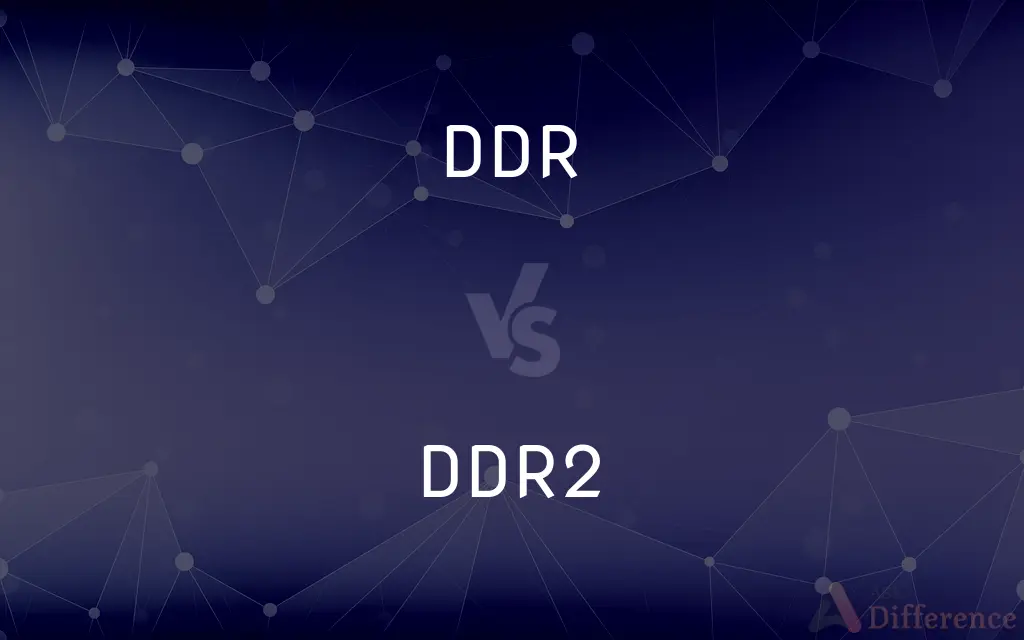DDR vs. DDR2 — What's the Difference?
Edited by Tayyaba Rehman — By Fiza Rafique — Published on November 12, 2023
DDR (Double Data Rate) is a type of SDRAM. DDR2 is its successor, offering improved speed, size, and power efficiency.

Difference Between DDR and DDR2
Table of Contents
ADVERTISEMENT
Key Differences
DDR (Double Data Rate) brought a revolutionary approach to data transfer by doubling the rate without increasing the actual clock frequency, thereby improving data throughput. In contrast, DDR2 takes this principle a step further, optimizing power usage and allowing even higher speeds, without directly paralleling an increase in power consumption.
DDR operates by transferring data on both the rising and falling edges of the clock signal, boosting data bandwidth without necessitating a higher clock frequency. DDR2 enhances this by utilizing a four-bit prefetch buffer, effectively doubling the data throughput, while simultaneously using a lower voltage, contributing to power efficiency.
While DDR memory modules typically operate at voltages around 2.5V, delivering data rates between 200 - 400 MT/s (million transfers per second), DDR2 propels data rates between 400 - 800 MT/s, making it a preferable choice for systems requiring superior speed and data handling, while functioning at a lower voltage of approximately 1.8V.
The physical distinctions between DDR and DDR2 are subtle yet crucial; for instance, DDR RAM typically has 184 pins, while DDR2 RAM sports 240 pins. DDR2's architecture allows larger chip capacities, enabling users to utilize more memory and thereby assisting in handling more data and enhancing overall system capabilities.
DDR, despite being outmoded by DDR2 and its subsequent iterations, serves as a pivotal milestone in memory technology, establishing the framework for data rate doubling without clock frequency augmentation. On the flip side, DDR2 refines this framework, laying down the foundation for the successive generations of memory technologies that we witness today.
ADVERTISEMENT
Comparison Chart
Data Rates
200 - 400 MT/s
400 - 800 MT/s
Operating Voltage
Approximately 2.5V
Approximately 1.8V
Physical Attributes
184 pins
240 pins
Prefetch Buffer
2 bits
4 bits
Technology Basis
Data transfer on rising and falling clock edges
Improved with higher prefetch and lower voltage
Compare with Definitions
DDR
DDR operates at a higher voltage compared to its successors.
DDR utilizes approximately 2.5V to function.
DDR2
DDR2 delivers data rates between 400 - 800 MT/s.
DDR2 capabilities allow it to handle between 400 and 800 million transfers per second.
DDR
DDR offers 200 - 400 MT/s of data rate.
DDR can transfer between 200 and 400 million units of data per second.
DDR2
DDR2 provides advancements in speed and efficiency over DDR.
DDR2 manages to deliver data at twice the rate of DDR while consuming less power.
DDR
DDR achieves double data transfer on a single clock cycle.
DDR effectively doubles the data transfer rate without increasing the clock speed.
DDR2
DDR2 operates at a lower voltage than DDR.
DDR2 efficiently operates using approximately 1.8V.
DDR
DDR employs a 2-bit prefetch buffer.
DDR fetches 2 bits of data in a single memory access.
DDR2
DDR2 utilizes a 4-bit prefetch buffer for data retrieval.
The 4-bit prefetch buffer in DDR2 enhances data throughput.
DDR
DDR modules typically feature 184 pins.
A DDR RAM stick visibly showcases 184 connection pins.
DDR2
DDR2 memory modules come with 240 pins.
When examining a DDR2 stick, you can observe 240 pins on the module.
Common Curiosities
Are DDR and DDR2 modules physically interchangeable?
No, DDR has 184 pins while DDR2 has 240, making them physically incompatible.
What is the core function of DDR?
DDR allows doubled data transfer rates per clock cycle.
Can DDR2 be used in slots designed for DDR?
No, the pin configuration and architecture differences prevent interchangeability.
How does DDR2 improve upon DDR’s functionality?
DDR2 enhances speed, reduces power consumption, and provides larger data bandwidth via a 4-bit prefetch buffer.
Why might one choose DDR over DDR2 in certain scenarios?
DDR might be chosen for compatibility with older hardware systems.
Can DDR handle data as efficiently as DDR2?
No, DDR2 provides superior data handling and transfer rates compared to DDR.
Is DDR2 backward compatible with DDR?
No, DDR2 is not backward compatible with DDR due to physical and architectural differences.
How does DDR2 influence power consumption in systems?
DDR2 operates at a lower voltage than DDR, thus reducing the overall power consumption in systems.
Does DDR2 consume more power than DDR?
No, DDR2 operates at a lower voltage, consuming less power than DDR.
What is a notable physical difference between DDR and DDR2?
DDR typically has 184 pins, while DDR2 features 240 pins.
Are DDR2 modules more expensive than DDR modules?
Prices may vary, but DDR2 modules can be pricier than DDR due to enhanced capabilities, though both are outdated compared to newer technologies.
Can a system operate using both DDR and DDR2?
No, systems cannot utilize DDR and DDR2 simultaneously due to physical and electrical discrepancies.
Why does DDR2 offer enhanced speed over DDR?
DDR2 uses a 4-bit prefetch buffer, allowing it to handle more data and operate at higher speeds than DDR.
How do DDR and DDR2 affect system performance?
Both impact data transfer rates and bandwidth, but DDR2 generally enables better system performance due to its improved capabilities.
Will DDR and DDR2 be supported in future hardware?
Both DDR and DDR2 are becoming increasingly obsolete, with modern hardware typically supporting DDR4 and DDR5.
Share Your Discovery

Previous Comparison
Stacking Gel vs. Separating Gel
Next Comparison
Goose Bumps vs. Goose PimplesAuthor Spotlight
Written by
Fiza RafiqueFiza Rafique is a skilled content writer at AskDifference.com, where she meticulously refines and enhances written pieces. Drawing from her vast editorial expertise, Fiza ensures clarity, accuracy, and precision in every article. Passionate about language, she continually seeks to elevate the quality of content for readers worldwide.
Edited by
Tayyaba RehmanTayyaba Rehman is a distinguished writer, currently serving as a primary contributor to askdifference.com. As a researcher in semantics and etymology, Tayyaba's passion for the complexity of languages and their distinctions has found a perfect home on the platform. Tayyaba delves into the intricacies of language, distinguishing between commonly confused words and phrases, thereby providing clarity for readers worldwide.












































